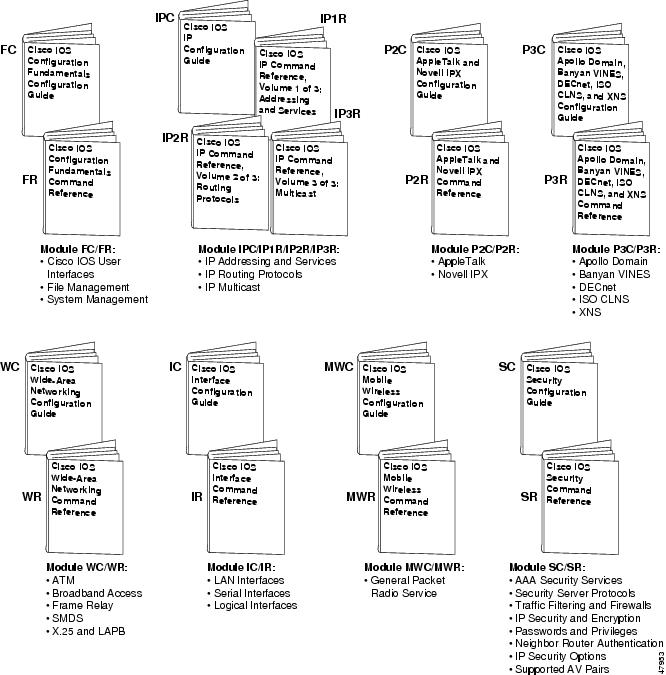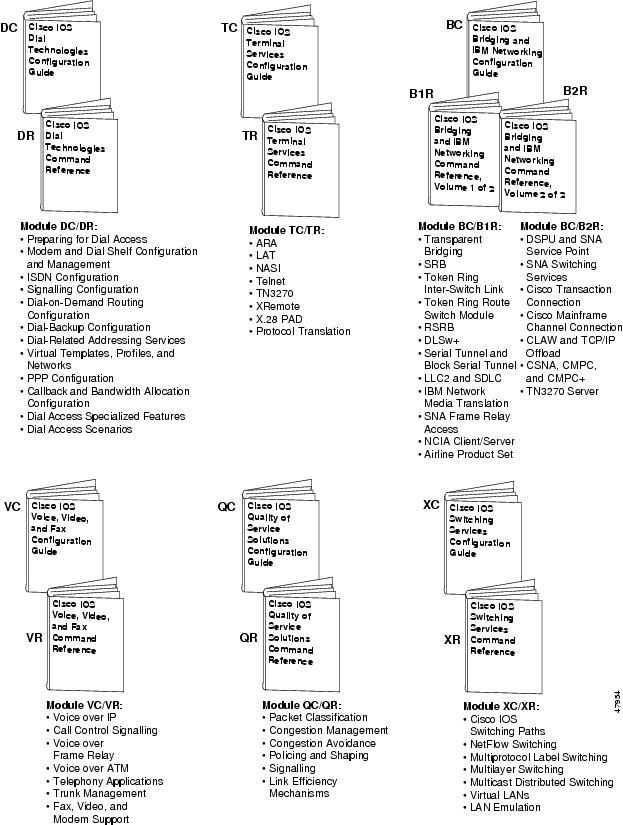

-
Cisco IOS Switching Services Configuration Guide, Release 12.2
-
About the Cisco IOS Software Documentation
-
Using Cisco IOS Software
-
Cisco IOS Switching Services Overview
- Part 1: Cisco IOS Switching Paths
- Part 2: NetFlow
- Part 3: Multiprotocol Label Switching
- Part 4: Multilayer Switching
- Part 5: Multicast Distributed Switching
- Part 6: Virtual LANs
- Part 7: LAN Emulation
-
Table Of Contents
About Cisco IOS Software Documentation
Supporting Documents and Resources
About Cisco IOS Software Documentation
This chapter discusses the objectives, audience, organization, and conventions of Cisco IOS software documentation. It also provides sources for obtaining documentation from Cisco Systems.
Documentation Objectives
Cisco IOS software documentation describes the tasks and commands necessary to configure and maintain Cisco networking devices.
Audience
The Cisco IOS software documentation set is intended primarily for users who configure and maintain Cisco networking devices (such as routers and switches) but who may not be familiar with the tasks, the relationship between tasks, or the Cisco IOS software commands necessary to perform particular tasks.
Documentation Organization
The Cisco IOS software documentation set consists of documentation modules and master indexes. In addition to the main documentation set, there are supporting documents and resources.
Documentation Modules
The Cisco IOS documentation modules consist of configuration guides and corresponding command reference publications. Chapters in a configuration guide describe protocols, configuration tasks, and Cisco IOS software functionality and contain comprehensive configuration examples. Chapters in a command reference publication provide complete Cisco IOS command syntax information. Use each configuration guide in conjunction with its corresponding command reference publication.
Figure 1 shows the Cisco IOS software documentation modules.
Note
The abbreviations (for example, FC and FR) next to the book icons are page designators, which are defined in a key in the index of each document to help you with navigation. The bullets under each module list the major technology areas discussed in the corresponding books.
Figure 1 Cisco IOS Software Documentation Modules
Master Indexes
Two master indexes provide indexing information for the Cisco IOS software documentation set: an index for the configuration guides and an index for the command references. Individual books also contain a book-specific index.
The master indexes provide a quick way for you to find a command when you know the command name but not which module contains the command. When you use the online master indexes, you can click the page number for an index entry and go to that page in the online document.
Supporting Documents and Resources
The following documents and resources support the Cisco IOS software documentation set:
•
Cisco IOS Command Summary (two volumes)—This publication explains the function and syntax of the Cisco IOS software commands. For more information about defaults and usage guidelines, refer to the Cisco IOS command reference publications.
•
Cisco IOS System Error Messages—This publication lists and describes Cisco IOS system error messages. Not all system error messages indicate problems with your system. Some are purely informational, and others may help diagnose problems with communications lines, internal hardware, or the system software.
•
Cisco IOS Debug Command Reference—This publication contains an alphabetical listing of the debug commands and their descriptions. Documentation for each command includes a brief description of its use, command syntax, usage guidelines, and sample output.
•
Internetworking Terms and Acronyms—This Cisco publication compiles and defines the terms and acronyms used in the internetworking industry.
•
New feature documentation—Feature module documentation introduces new networking functionality, released after the publication of the Cisco IOS software documentation set, that supports Cisco networking technology and hardware.
•
Release notes—This documentation describes system requirements, provides new and changed information, and includes other useful information about specific software releases.
•
Caveats documentation—This documentation provides information about Cisco IOS software defects in specific software releases.
New and Changed Information
Since the last release of the Cisco IOS Switching Services Configuration Guide, the term `quality of service' (QoS) replaces the term `class of service' (CoS). All references to Multiprotocol Label Switching (MPLS) CoS functionality has been replaced by the MPLS QoS functionality, which is documented in the "Multiprotocol Label Switching Overview" chapter and the "Configuring Multiprotocol Label Switching" chapter.
Document Conventions
The Cisco IOS documentation set uses the following conventions:
Examples use the following conventions:
The following conventions are used to attract the attention of the reader:
CautionMeans reader be careful. In this situation, you might do something that could result in equipment damage or loss of data.
Note
Means reader take note. Notes contain helpful suggestions or references to materials not contained in this manual.
Timesaver
Means the described action saves time. You can save time by performing the action described in the paragraph.
Within Cisco IOS software documentation, the term router is generally used to refer to a variety of Cisco products (for example, routers, access servers, and switches). Routers, access servers, and other networking devices that support Cisco IOS software are shown interchangeably within examples. These products are used only for illustrative purposes; that is, an example that shows one product does not necessarily indicate that other products are not supported.
Command Syntax Conventions
Command syntax descriptions use the following conventions:
Cisco.com
Cisco.com is the foundation of a suite of interactive, networked services that provides immediate, open access to Cisco information and resources at any time, from anywhere in the world. This highly integrated Internet application is a powerful, easy-to-use tool for doing business with Cisco.
Cisco.com provides a broad range of features and services to help customers and partners streamline business processes and improve productivity. Through Cisco.com, you can find information about Cisco and our networking solutions, services, and programs. In addition, you can resolve technical issues using online technical support, you can download and test software packages, and you can order Cisco learning materials and merchandise. Valuable online skill assessment, training, and certification programs are also available.
Customers and partners can self-register on Cisco.com to obtain additional personalized information and services. Registered users can order products, check on the status of an order, access technical support, and view benefits specific to their relationships with Cisco.
To access Cisco.com, go to the following website:
http://www.cisco.com
World Wide Web
You can access the most current Cisco documentation on the World Wide Web at the following sites:
•
http://www.cisco.com
•
http://www-china.cisco.com
•
http://www-europe.cisco.com
Documentation CD-ROM
Cisco documentation and additional literature are available in a CD-ROM package, which ships with your product. The Documentation CD-ROM is updated monthly and may be more current than printed documentation. The CD-ROM package is available as a single unit or as an annual subscription.
Ordering Documentation
Cisco documentation can by ordered in the following ways:
•
Registered Cisco Direct Customers can order Cisco product documentation from the Networking Products MarketPlace:
http://www.cisco.com/cgi-bin/order/order_root.pl
•
Registered Cisco.com users can order the Documentation CD-ROM through the online Subscription Store:
http://www.cisco.com/go/subscription
•
Nonregistered Cisco.com users can order documentation through a local account representative by calling Cisco corporate headquarters (California, USA) at 408 526-7208 or, in North America, by calling 800 553-NETS(6387).
Documentation Feedback
If you are reading Cisco product documentation on the World Wide Web, you can submit technical comments electronically. Click Feedback in the toolbar and select Documentation. After you complete the form, click Submit to send it to Cisco.
You can e-mail your comments to bug-doc@cisco.com.
To submit your comments by mail, for your convenience many documents contain a response card behind the front cover. Otherwise, you can mail your comments to the following address:
Cisco Systems, Inc.
Document Resource Connection
170 West Tasman Drive
San Jose, CA 95134-9883We appreciate your comments.

 Feedback
Feedback



